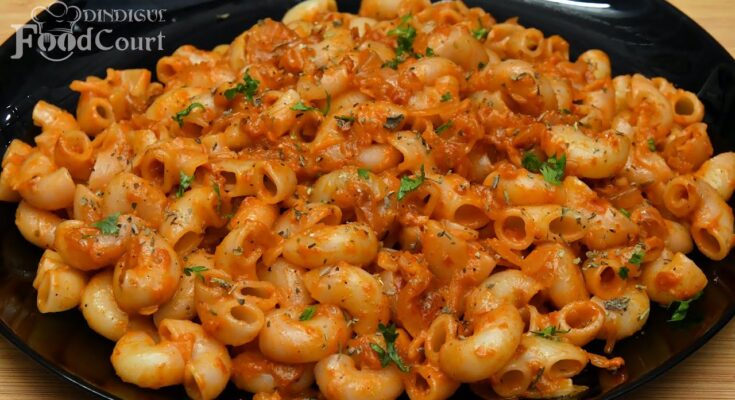Pasta Recipe: Pasta, a beloved staple in cuisines worldwide, is more than just a meal—it’s a tradition. Originating in Italy, this versatile food has taken many forms and variations, with recipes handed down through generations.
Whether you choose to make it from scratch or buy it from the store, pasta offers endless possibilities for creativity and flavor.
While store-bought pasta is convenient, making your own at home adds a personal touch and unbeatable freshness.
Ready to dive into the art of pasta-making? Let’s get started!
Essential Ingredients for Pasta
Before you begin, gather the basic ingredients for pasta dough:
- Flour: All-purpose flour works fine, but for authentic results, use 00 flour or semolina.
- Eggs: Fresh eggs provide richness and structure.
- Salt: A pinch enhances the flavor of the dough.
- Optional Variations: Add spinach puree for green pasta or squid ink for black pasta.
For those with dietary restrictions, gluten-free flour or egg substitutes can also be used, though they may require slight adjustments in technique.
Necessary Tools for Pasta Preparation
To craft perfect pasta, you’ll need:
- Rolling Pin: For hand-rolling your dough.
- Pasta Machine: A handy tool for even thickness and faster rolling.
- Mixing Bowl: To combine ingredients with ease.
- Cutting Tools: A sharp knife or pasta cutter for shaping your noodles.
If you don’t have these tools, don’t worry—creativity and a little elbow grease can work wonders!
Step 1: Preparing the Pasta Dough
Start with the base of any great pasta: the dough.
- Create a Flour Well: On a clean surface, mound your flour and make a well in the center.
- Add Eggs: Crack the eggs into the well and sprinkle in a pinch of salt.
- Mix: Gradually combine the flour and eggs with a fork, pulling flour from the edges into the liquid center.
- Knead: Once the mixture comes together, knead the dough for 8–10 minutes until it’s smooth and elastic.
If your dough feels too sticky, add a bit more flour. Too dry? Sprinkle in a few drops of water. Achieving the perfect consistency takes practice, but don’t give up!
Step 2: Resting the Dough
Resting allows the gluten to relax, making the dough easier to roll out.
- Wrap It Up: Cover the dough in plastic wrap or place it in a zip-top bag.
- Rest: Let it sit at room temperature for 30 minutes to an hour.
Skipping this step might result in tough, unworkable dough, so patience is key. While the dough rests, you can prepare your tools and think about the shape and sauce you’ll pair with your pasta.
Step 3: Rolling Out the Dough
Now that your dough is rested and ready, it’s time to roll it out.
- Divide the Dough: Cut the dough into smaller portions to make it easier to work with.
- Flour the Surface: Lightly dust your rolling surface and rolling pin or pasta machine to prevent sticking.
- Roll by Hand: If using a rolling pin, start from the center and roll outward, rotating the dough frequently to maintain an even thickness. Aim for a thin sheet—around 1-2 millimeters, depending on the pasta type.
- Use a Pasta Machine: Feed the dough through the widest setting first, then gradually reduce the thickness setting as you go. Fold and repeat as needed for a smooth, even sheet.
Consistency is crucial here—uneven dough will lead to uneven cooking. Take your time and enjoy the process!
Step 4: Cutting the Pasta
With your dough rolled out, it’s time to transform it into your desired pasta shape.
- For Long Pasta: Use a knife or a pasta cutter to slice the dough into strips for fettuccine, tagliatelle, or linguine.
- For Stuffed Pasta: Cut out circles or squares for ravioli or tortellini, then fill with your chosen ingredients.
- For Short Pasta: Shape into small pieces like farfalle or orecchiette by hand.
If you’re feeling adventurous, you can experiment with unique shapes—just ensure they’re evenly sized for consistent cooking.
Step 5: Cooking the Pasta
Fresh pasta cooks faster than dried pasta, so keep a close eye on it.
- Boil Water: Use a large pot of water with plenty of salt. It should taste as salty as the sea!
- Cook: Add the pasta and stir gently to prevent clumping. Fresh pasta typically cooks in 2-4 minutes.
- Taste Test: Check for doneness—your pasta should be tender but slightly firm to the bite (al dente).
- Drain and Serve: Save some pasta water before draining; it’s perfect for enhancing your sauce.
Don’t rinse your pasta! The starch on the surface helps sauces stick better, creating a more cohesive dish.
Pairing Pasta with Sauces
Pairing the right pasta with the right sauce is like finding the perfect dance partner—it can elevate the entire experience.
- Long, Thin Pasta: Best with light, oil-based sauces like aglio e olio or simple butter and garlic.
- Wide, Flat Pasta: Stands up well to hearty, creamy sauces like Alfredo or Bolognese.
- Short Pasta: Works wonderfully with chunky sauces, such as marinara or pesto.
For an extra burst of flavor, toss the pasta directly in the sauce on low heat for a minute or two before serving. It’s a game-changer!
Serving Your Pasta
Presentation matters as much as taste when serving pasta.
- Garnish: Top with freshly grated Parmesan, chopped parsley, or a drizzle of olive oil.
- Side Dishes: Serve with crusty garlic bread, a fresh green salad, or roasted vegetables.
- Plating: Twirl long pasta into neat nests or use a ring mold for short pasta for a restaurant-style look.
Adding thoughtful details to your presentation can turn a simple meal into a feast for the senses.
Storing Leftover Pasta
Leftovers can be just as delicious when stored correctly.
- For Cooked Pasta: Toss with a little olive oil to prevent sticking and store in an airtight container in the refrigerator for up to three days.
- For Uncooked Pasta: Dust with flour, lay flat on a tray, and freeze. Once solid, transfer to a zip-top bag.
- Reheating: Warm cooked pasta gently in a skillet with a splash of water or sauce to keep it moist.
Avoid microwaving, which can make your pasta rubbery.
Homemade Pasta vs. Store-Bought Pasta
Making pasta from scratch might seem intimidating, but the rewards are worth it.
- Homemade Pasta: Fresh, tender, and customizable. You control the ingredients and can experiment with flavors.
- Store-Bought Pasta: Convenient and shelf-stable but lacks the fresh taste and texture of homemade pasta.
Homemade pasta is a labor of love, and the satisfaction of crafting your own is unmatched.
Tips and Tricks for Perfect Pasta
Want to level up your pasta game? Keep these tips in mind:
- Use the Right Flour: 00 flour or semolina for authenticity.
- Don’t Overwork the Dough: Knead just enough to achieve smooth elasticity.
- Salt Generously: Properly seasoned water makes a world of difference.
- Save Pasta Water: It’s a magical ingredient for enhancing sauces.
Even small details can make a big impact on your final dish.
Regional Variations in Pasta Recipes
Pasta isn’t just Italian—it’s a global phenomenon!
- Italy: Think classic spaghetti carbonara or lasagna Bolognese.
- Asia: Ramen and rice noodles offer a unique twist.
- America: Comfort foods like mac and cheese show pasta’s versatility.
Exploring these variations can inspire endless culinary adventures.
FAQs about Pasta Recipe
1. What are the essential ingredients for a basic pasta recipe?
A basic pasta recipe typically includes flour, eggs, and a pinch of salt. For variations, some recipes may include olive oil or water.
2. How do I prevent pasta from sticking together while cooking?
To prevent pasta from sticking, use a large pot with plenty of water and stir occasionally during the first few minutes of cooking. Adding a tablespoon of olive oil can also help.
3. How can I tell when pasta is perfectly cooked?
Perfectly cooked pasta, known as al dente, is firm to the bite but not hard. To test, take a piece and bite into it—it should have a slight resistance in the center.
4. Can I make pasta without eggs?
Yes, eggless pasta is common and can be made using flour and water. Semolina flour is often used for a sturdier texture.
5. What is the best way to store leftover cooked pasta?
Store leftover pasta in an airtight container in the refrigerator for up to 3-5 days. Adding a drizzle of olive oil can prevent clumping.
6. Can I freeze homemade pasta dough?
Yes, you can freeze homemade pasta dough. Wrap it tightly in plastic wrap and store it in an airtight container for up to a month. Thaw in the fridge before using.
7. What sauces pair best with different pasta shapes?
Thin sauces like marinara pair well with long, thin pasta (e.g., spaghetti), while hearty, chunky sauces complement short pasta shapes like penne or rigatoni.
8. How do I make gluten-free pasta at home?
To make gluten-free pasta, use gluten-free flour alternatives like rice flour, almond flour, or a pre-made gluten-free flour mix. Adjust liquid ratios as needed.
Conclusion
Making pasta at home is a rewarding experience that combines tradition, creativity, and delicious results. Whether you’re a seasoned chef or a curious beginner, the steps outlined here will guide you toward mastering this timeless dish. So, roll up your sleeves, sprinkle some flour, and start crafting your perfect pasta today!



